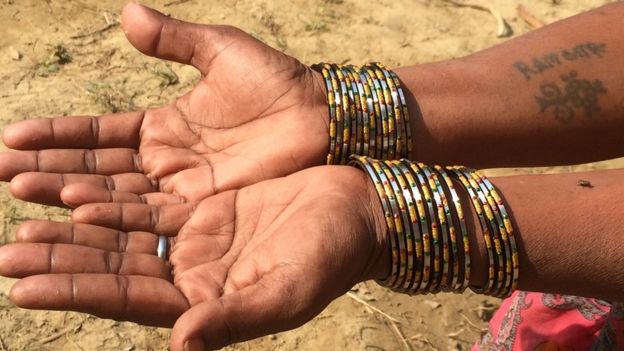‘Don’t brand me’: The Indian women saying no to forced tattoos
In India, and across the world, getting a tattoo is nowadays seen as a sign of independence and rebellion. Many young people get inked to showcase their identity, what makes them distinctive and who they are.
But for me, a decision to not get a tattoo was my version of rebellion, an assertion of my hard-fought independence.
It was my way of saying: “I will not toe the line.”
I grew up thinking of tattoos, along with nose and ear piercings, as symbols of the subjugation of women.
That’s because my mother has a couple of tattoos. And my grandmother had more than a couple. And they told me they had no choice in the matter.
In many rural communities in the northern Indian state of Uttar Pradesh, where my family comes from, it’s mandatory for married women to have tattoos, locally known as Godna.
“My family told me that if I didn’t have a tattoo, no-one in my matrimonial home would drink water or take food offered by me. I’d be considered impure, an untouchable,” my mother told me recently. My father, of course, didn’t need to get one because, as mum says, “he was a boy”.
She was a child bride, not even 11 at the time of her wedding in the 1940s. A few weeks after the ceremony, an elderly woman who lived in the neighbourhood was called to the house to brand her.
Source: ‘Don’t brand me’: The Indian women saying no to forced tattoos by Geeta Pandey, BBC News, Delhi, 4 October 2017
URL: https://www.bbc.co.uk/news/world-asia-india-41466751
Date accessed: 30 July 2020

Photo: BBC News
Geeta Pandey, BBC News, Delhi, 4 October 2017 | Read the full article with more images >>
In India, and across the world, getting a tattoo is nowadays seen as a sign of independence and rebellion. Many young people get inked to showcase their identity, what makes them distinctive and who they are. But for me, a decision to not get a tattoo was my version of rebellion, an assertion of my hard-fought independence. It was my way of saying: “I will not toe the line.” […]
Keya Pandey, a social anthropologist at Lucknow University who has researched tattoos extensively in rural and tribal India, says flora and fauna are among the preferred designs. Also high on the list are the names of husbands or fathers, or even the village, totems or other symbols of cultural or clan identity, and images of a god or local deity. Ms Pandey says she’s seen tattoos in every rural culture in India and estimates that millions of women in villages have them. In some communities, especially in tribal areas, both men and women have tattoos. […]
Traditions and folklore are being modified and girls in villages are no longer interested in getting a tattoo, Ms Pandey says.
Nowhere is that more evident than among the girls of the Baiga tribe in central India. For more than 2,000 years, the women here have been getting branded. […]There are also communities where women get tattoos for the purpose of beautification – though there are instances where low-caste women got tattooed to make themselves ugly and less desirable to avoid being sexually assaulted by influential men. But in many communities, as in my ancestral village, tattoos are meant only for a woman, a sign of her marital status.
For my mother and grandmother, they were a symbol of purity, the idea that unless a woman was put through a painful purification ritual, she was not fit to serve the patriarchy.
The practice, however, is declining – and many young women, even girls, are saying no to being branded. With modernity and development creeping in and growing contact with the outside world, things are changing in rural and tribal India.
Traditions and folklore are being modified and girls in villages are no longer interested in getting a tattoo […]
New Zealand: Maori customs
Ta Moko is the traditional form of tattooing in Maori culture. Each tattoo is exceptionally unique and resembles the wearer’s social status. | Read the full report in The Times of India Travel, 28 May 2018 >>
The tattoos also reveal the wearer’s tribal affiliations, and tribal messages from ancestors to their current generation. Moko is typically a visual language, which connects a person to his family tree. Traditionally, they would use knives and chisels made from shark teeth and ink made from gum, burnt wood, or other natural products. But now, people opt for modern techniques for tattooing.
Find publications on this topic on WorldCat.org by searching for “Baiga tribe tattoo”, “India women tattoo”, “tribal custom central India” or similar combinations):
Indian tribal cultural heritage: museum collections, eBooks, maps & more
Anthropological Survey | Anthropology
Books on tribal culture and related resources
Crafts and visual arts | Homes and utensils Crafts and visual arts | Masks
Cultural heritage | Revival of traditions
Dress and ornaments | Fashion | Tattoo
eBook | Background guide for education
eBook | Free catalogue: Banam: One of the ancient musical instruments of the Santals – West Bengal
eBook | Free catalogue: Museum of Santal Culture (Bishnubati) – West Bengal
Games and leisure time | Martial arts
India’s 28 States and 8 Union Territories – From Andhra Pradesh to West Bengal
Tribal customs, homes and ornaments in South India: Videos and photographs by Vicky Lakshmanan
Tips for using interactive maps
Toggle to normal view (from reader view) should the interactive map not be displayed by your tablet, smartphone or pc browser
For details and hyperlinks click on the rectangular button (left on the map’s header)
Scroll and click on one of the markers for information of special interest
Explore India’s tribal cultural heritage with the help of another interactive map >>